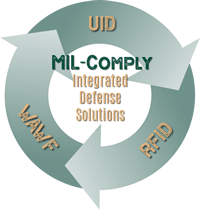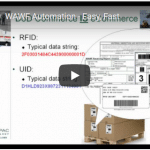WAWF Automation simplifies Wide Area Workflow compliance.
WAWF Automation
MIL-Comply takes the drudgery out of shipping by eliminating redundant data-entry. The result is faster and more accurate shipments. MIL-Comply’s robust features minimize data-entry with the use of databases and special widgets. Critical information like IUIDs are entered just once per shipment, then used for labeling, RFID tagging and WAWF submission. Importing data from spreadsheets and business systems is easy. And using EDI purchase orders allows you to process orders with almost no manual data-entry.
Scalable from Small Companies to Large Enterprise
MIL-Comply lets you automate a little of your process or the whole thing. You can start small and add more automation features as you go, on a single machine or distributed across your contract shipping team.

The advantages enjoyed by many large enterprises by electronically submitting Receiving Reports, Invoices, RFID and UID data to Wide-Area Workflow (WAWF) are available to smaller companies by using MIL-Comply. Collecting and organizing WAWF data offline, then submitting it electronically saves time and reduces rejections. The generation of the WAWF DD250 Receiving Reports is built in to MIL-Comply, along with six different kinds of WAWF invoices to speed payments.
Using the same information for Mil-Std-129 labeling and WAWF DD250s decreases effort while increasing accuracy. MIL-Comply automatically collects and organizes RFIDs and UIDs as labels are created, submitting them electronically. This is substantially more efficient, and eliminates the errors and rejections inherent in manual data-entry.
Integrate Wide Area Workflow into Your Shipping Process
You may already be collecting and organizing Wide-Area Workflow data in your business systems then manually entering it into the government’s web application. Importing that data into MIL-Comply can save time and reduce errors. Learn more about integrating Mil-Comply with business systems.
The burden of Item Unique Identifiers (IUID) processing is a main driver for Wide Area Workflow automation, resulting in substantial time savings. The need for each IUID to appear on container labels, be associated with RFID tags, and be included on DD250s can generate five or more UID touch points per shipment. MIL-Comply eliminates this by performing all tasks from the same UID data. It provides many ways to accept/import UID data to eliminate data-entry altogether.
Entering a large number of IUIDs data into the WAWF web application can prove to be aggravating and error-prone. And correcting mistakes after WAWF acceptance requires access to the UID Registry, which presents its own set of challenges. With MIL-Comply you simply paste a list of UIIs into the database, where they may be submitted to WAWF and/or used for labeling. It is fast, easy and avoids costly errors. Even submitting embedded UID items is easy with MIL-Comply.
You may already be collecting and organizing Wide-Area Workflow data in your business systems then manually entering it into the government’s web application. Importing that data into MIL-Comply can save time and reduce errors. Learn more about integrating Mil-Comply with business systems.
Shipping Government Furnished Property (GFP) UID items is just a bit more complicated than making new acquisition UID shipments. The first issue is a need to use the Reparable Receiving Report (RRR) rather than a standard WAWF DD250 Receiving Report (RR). Fortunately, the RRR is simply an RR with additional information. The main difference is that upon acceptance of the shipment WAWF transfers custody of the UID items from the contractor to the Government rather than adding them to the IUID Registry.
Complicating matters, custody of GFP UID items must be acknowledged with the IUID Registry before shipping on a Reparable Receiving Report. Any non-existent items must be added to the Registry.
MIL-Comply’s GFP Automation solution streamlines this entire process, allowing GFP shipments to be accomplished without logging into PIEE website to access WAWF and UID Registry. View our GFP Shipping Process video for to learn more about how MIL-Comply speeds and simplifies the process.
Reducing the burden of RFID and UID compliance are two of the strongest motivations for WAWF automation, as both can require the collection and correlation of large amounts of data that must be manually entered into the government’s web application.
Using MIL-Comply to organize and submit RFID data to WAWF offers advantages for:
- Large Shipments – entering a large number of RFIDs, along with the CLIN and quantity associated with each, is a burden that is eliminated Comply/Labeling and Comply/RFID Manager.
- Palletized Loads – create an additional headache when done manually, but with MIL-Comply it can all be done automatically when the RFID labels are printed for the exterior containers. There is nothing else to do but click and submit.
- UID shipments – require each UII to be associated with the RFID of its container, then submitted to Wide-Area Workflow. If palletized, the UID, Case and Pallet RFID data must all be correlated. This is very simple to do with Comply/Labeling. Simply paste in a list of UIIs, specify the number of UID items per container, the number of containers per pallet. Then print, slap and ship. The RFID data is automatically correlated for submission to WAWF as an RFID Update or as part of a WAWF Receiving Report.
- Multi-Box UIDs – can be a significant challenge in WAWF, since the UII-marked item is shipped in multiple boxes. Each box must have its own RFID Case tag, resulting in multiple Cases per item and a Case/CLIN count that does not match the number shipped. While this can be a painful exercise on the free web application, MIL-Comply makes it simply, automatically organizing and submitting this complex data to WAWF.
The WAWF web site is one way to submit invoices. However, for companies that create invoice data in their own business systems this approach often duplicates efforts. This is particularly true for DIBBS EDI orders, as explained below.
Contractors may submit invoices electronically, bypassing use of the WAWF web site by creating electronic data interchange (EDI) transactions. Take a look at WAWF invoicing via EDI submission and see how MIL-Comply can speed and simplify this process.
DLA DIBBS orders create a challenge due to high volumes and low margins. Eliminating WAWF invoice data-entry can save considerable time. MIL-Comply instantly converts DIBBS EDI-850 purchase orders into Fast Pay Receiving Reports and Invoices, using the data received from DLA as electronic orders (EDI-850). Just add your invoice number and immediately submit to Wide Area Workflow, bypassing its web site.
EDI DIBBS orders can also drive Mil-Std-129 labeling. Adding VSM Automation allows you to ship without the need to interact with the DLA web site, saving even more time. MIL-Comply makes the process nearly effortless, saving time and eliminating errors. Learn more…
About 90% of the data required for Mil-Std-129 labeling exists on WAWF DD250 Receiving Reports, so it makes a lot of sense to use the same data to produce both. Even more so when RFID and IUID are included. MIL-Comply collects and organizes that data while printing IUID container labels, making it immediately available to submit to WAWF to request shipment acceptance.
Submitting data to WAWF electronically reduces time and effort while increasing accuracy. Companies that manage shipment data in their business systems export it to MIL-Comply to drive labeling and WAWF shipments for maximum efficiency.
Many large enterprises integrate Wide Area Workflow data processing into their business systems using electronic data interchange (WAWF EDI) formats (ANSI X12). This allows these businesses to leverage shipment data managed by their business systems to drive Mil-Std-129 labeling and submit Receiving Reports and invoices to Wide Area Workflow. All without ever going on the WAWF web site.
MIL-Comply makes WAWF integration easily available and affordable to companies of any size. And it works with anything from a list of IUIDs to CSV import of WAWF-ready shipments. Whatever your system cannot provide, your MIL-Comply users can simply fill in. This allows anything from a spreadsheet to an ERP system to provide data to simplify creation of Mil-Std-129 labeling and WAWF Receiving Reports, using the data you already have.
Avoid re-entering data into labeling systems and the WAWF web site. Just hand it to MIL-Comply to automate the process.
Companies managing big long-term contracts may be happy to know that MIL-Comply easily handles creation of Cost Vouchers (SF1034), Progress Payment Requests (SF1443), and even Navy Shipbuilding Invoice (NSI) transactions.
Learn more about integrating Mil-Comply with business systems.
Watch this video on how WAWF automation simplifies submission of IUID and RFID to Wide Area Workflow, integrates with Mil-Std-129 labeling, DIBBS purchase orders and VSM shipping instructions to speed the shipment process. 

